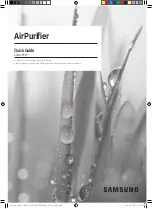
10
blower Speed - ECM Motor
WARNING:
To prevent electric shock, personal injury,
or death, turn off the electric power at the
disconnect or the main service panel before
making any electrical connections.
For optimum system performance and comfort, it may be
necessary to change the factory speed setting.
1. Disconnect all electrical power to the unit and remove
the service panel.
2. Locate the orange and red wires terminated to the blower
motor.
NOTE:
The orange wire controls cooling operation
and the red wire controls the heating operation.
3. Verify the required speed from the airflow data found
in Table 3 (page 9). Place appropriate wire on the
appropriate motor speed tap for the required airflow.
4. Check all factory wiring as shown in the wiring diagram
and inspect the connections to make sure none of them
loosened during shipping or installation.
START UP & ADJUSTMENTS
Pre-Start Checklist
The following check list should be observed prior to
starting the unit.
√
Verify the unit is level and allows proper condensate
drainage.
√
Verify the outdoor coil and top of the unit are free from
obstructions and debris, and all equipment access/
control panels are in place. Unit must be installed with
the proper clearances shown in Figure 1 (page 4).
√
Verify that the duct work is sealed to prevent air leakage.
√
Verify that the line voltage power leads are securely
connected and the unit is properly grounded. Check
the condenser fan to make sure it turns freely.
√
Verify the thermostat is wired correctly and installed
in a proper location. Make sure the low voltage wires
are securely connected to the correct leads on the low
voltage terminal strip.
√
Verify that the power supply branch circuit overcurrent
protection is sized properly.
√
To achieve rated capacity and efficiency the compressor
must be exposed to refrigerant for at least 24 hours
prior to running. After unit startup, the compressor must
run for a minimum of 12 hours.
Start-Up Procedure
NOTE:
The control circuit thermostat may consist of an
anti-short cycle timer that will not let the compressor re-
start before 3 - 5 minutes have elapsed.
1. Set the system mode to OFF and the temperature mode
to its highest setting.
2. Turn power on at the disconnect switch.
3. Set the system mode to ON or COOL.
4. Set the temperature mode below room temperature.
Verify that the indoor blower, outdoor fan, and
compressor energize and the cooling function starts.
5. Verify the discharge air grilles are adjusted and the
system air is balanced.
6. Verify the duct work has no air leaks.
7. Verify the condensate drain is installed correctly and
functions properly.
8. Set the temperature mode above room temperature.
The unit should stop.
9. Instruct the homeowner on unit and thermostat operation
and filter servicing.
System Cooling
Set the thermostat’s system mode to COOL and the fan
mode to AUTO. Lower the thermostat temperature selector
below the existing room temperature. Allow the cooling
system to operate for several minutes and check for the
discharge of cool air at the supply registers.
System Heating
(Available only when Electric heat is supplied) Set the
thermostat’s system mode to HEAT and the fan mode to
either AUTO (intermittent air) or to ON (continuous air).
Raise the thermostat’s temperature selector above the
existing room temperature and check the following:
1. The compressor and outdoor fan should not run.
2. The blower will run according to the thermostat’s fan
mode setting.
Charging the Unit in AC Mode with Outdoor
Temperatures Above 55° F
CAUTION:
This air conditioner contains liquid and gaseous
refrigerant under pressure. Adjustment of
refrigerant charge should only be attempted
by qualified, trained personnel thoroughly
familiar with the equipment and safe responsible
refrigerant handling procedures. Under no
circumstances should the homeowner attempt
to install and/or service this equipment. Failure
to comply with this warning could result in
equipment damage, personal injury, or death.
NOTE:
The refrigerant charge can be checked and adjusted
through the service ports provided external to the unit. Use
only gage line sets which have a “Schrader” depression
device present to actuate the valve.
1. With the system operating at steady-state, measure the
liquid refrigerant pressure in psig at the service valve.
2. Measure the liquid refrigerant temperature (° F) at the
service valve.
3. For the temperature measured, determine the required
liquid refrigerant pressure from Tables 4 - 9 (pages 16
- 18).
Содержание P7RD-A Series
Страница 19: ...19...






































